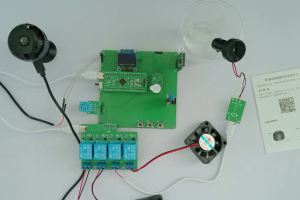设计说明书
总字数:19000+
摘要
在禽类养殖领域,孵化环境的精准调控对提高孵化率、保障雏鸡健康具有关键意义。传统的人工孵化管理方式不仅依赖经验判断、响应滞后,还存在劳动强度大、温湿度控制不稳定等问题,难以满足规模化、智能化养殖的需求。
基于 STM32F103C8T6 单片机的智能孵化器,整合了 DHT11 温湿度传感器、SW-420 震动监测模块、康帕斯 A9 摄像头、计时器、按键、OLED 显示屏、ESP8266WiFi 模块及执行设备(制冷装置、加热装置、通风装置、加湿装置、声光报警装置等),实现了孵化环境的自动化监测与智能调控。系统核心功能包括:通过 DHT11 实时监测温湿度,当温度大于最大值时打开制冷装置,小于最小值时打开加热装置,湿度大于最大值时打开通风装置,小于最小值时打开加湿装置,且温湿度超出范围时触发声光报警;通过计时器记录孵化时间并实时更新;借助 SW-420 震动监测模块检测小鸡是否孵化;通过康帕斯 A9 摄像头远程查看孵化情况;支持通过按键设置温湿度阈值等参数;通过 OLED 显示屏实时显示温湿度、孵化时间等测量值;利用 ESP8266WiFi 模块将数据传输至手机端,实现手机端设置参数、控制外设,监测到震动时手机弹窗提醒。
该系统的实现,有效提升了孵化环境调控的自动化与智能化水平,减少了人工干预,确保了孵化参数的稳定与精准,为规模化禽类孵化提供了高效、可靠的解决方案,同时为同类孵化设备的研发提供了参考,具有较高的实际应用价值。
关键词:STM32F103C8T6;智能孵化器;温湿度调控;震动监测;WiFi 通信
ABSTRACT
In the field of poultry breeding, precise regulation of the hatching environment is crucial for improving the hatching rate and ensuring the health of chicks. Traditional manual hatching management methods not only rely on empirical judgment with delayed responses but also suffer from high labor intensity and unstable temperature and humidity control, making them difficult to meet the needs of large-scale and intelligent breeding.
The intelligent incubator based on the STM32F103C8T6 microcontroller integrates DHT11 temperature and humidity sensors, SW-420 vibration monitoring modules, Compas A9 cameras, timers, buttons, OLED displays, ESP8266WiFi modules, and executive devices (refrigeration devices, heating devices, ventilation devices, humidification devices, sound and light alarm devices, etc.), realizing automatic monitoring and intelligent regulation of the hatching environment. The core functions of the system include: real-time monitoring of temperature and humidity through DHT11, turning on the refrigeration device when the temperature is higher than the maximum value, turning on the heating device when it is lower than the minimum value, turning on the ventilation device when the humidity is higher than the maximum value, turning on the humidification device when it is lower than the minimum value, and triggering an audible and visual alarm when the temperature and humidity are out of range; recording the hatching time through a timer and updating it in real-time; detecting whether the chicks are hatched by means of the SW-420 vibration monitoring module; remotely viewing the hatching situation through the Compas A9 camera; supporting the setting of parameters such as temperature and humidity thresholds through buttons; real-time display of measured values such as temperature, humidity, and hatching time through the OLED display; transmitting data to the mobile phone via the ESP8266WiFi module, enabling parameter setting, peripheral control on the mobile phone, and pop-up reminders on the mobile phone when vibration is detected.
The implementation of this system effectively improves the automation and intelligence level of hatching environment regulation, reduces manual intervention, ensures the stability and accuracy of hatching parameters, provides an efficient and reliable solution for large-scale poultry hatching, and also offers a reference for the research and development of similar hatching equipment, with high practical application value.
Keywords: STM32F103C8T6; Intelligent incubator; Temperature and humidity regulation; Vibration monitoring; WiFi communication
目录
第 1 章 绪论
1.1 研究的目的及意义
1.2 国内外发展情况
1.3 本文主要研究内容
第2章 设计思路与方案论证
2.1 主要元器件选择
2.1.1 主控芯片选择
2.1.2 温湿度传感器选择
2.1.3 震动监测模块选择
2.1.4 摄像头选择
2.1.5 显示模块选择
2.1.6 无线通信模块选择
2.1.7 按键模块选择
2.1.8 声光报警模块选择
2.2整体设计方案
第 3 章 硬件设计
3.1 主控电路模块
3.2 温湿度传感器电路
3.3 震动监测模块电路
3.4 摄像头电路
3.5 显示模块电路
3.6 无线通信模块电路
3.7 按键模块电路
3.8 执行设备驱动电路
3.9 声光报警模块电路
第4章 系统程序设计
4.1 编程软件介绍
4.2 系统主流程设计
4.3 独立按键
4.4 OLED显示流程设计
4.5 温湿度检测模块子流程
4.6 WiFi模块子流程设计
4.7 ADC模数转换子流程设计
第 5 章 仿真测试
5.1 整体仿真测试
5.2 温湿度传感器功能测试
5.3 震动监测模块功能测试
5.4 无线通信模块功能测试
5.5 声光报警模块功能测试
5.6 按键设置与显示功能测试
第 6 章 实物测试
6.1 整体实物测试
6.2 温湿度传感器功能测试
6.3 震动监测模块功能测试
6.4 摄像头功能测试
6.5 无线通信模块功能测试
6.6 声光报警模块功能测试
6.7 按键设置与显示功能测试
第 7 章 总结与展望
7.1 总结
7.2 展望
致谢
参考文献
附录
附录一:原理图
附录二:PCB
附录三:主程序
购买后可查看具体内容!

